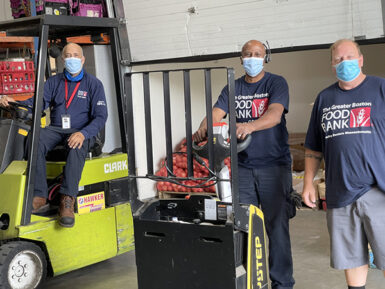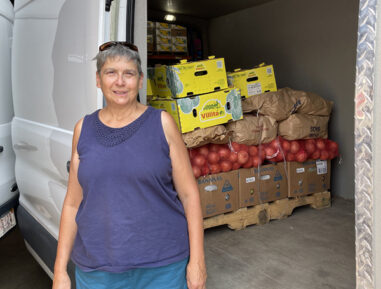The far-flung, hard-fought journey for nourishment
Nantucket, Home of soft sands, high end homes. And food insecurity?
Part Two: The far-flung, hard-fought journey for nourishment
It’s just after 2:00 p.m. on a drizzly Tuesday in downtown Nantucket, and already clients are lining up outside of the Nantucket Food Pantry an hour before it opens.
Food is distributed three days a week, from 3 to 6 p.m., on Tuesdays, Wednesdays, and Thursdays.

Tuesday is the busiest day at the pantry. It’s been four days since clients were able to pick up more food for their families. The Greater Boston Food Bank equitably distributes food to all partners across the Cape and the Islands through a cross-dock drop-off weekly. “Cross-dock” sites are places across Eastern Massachusetts where agencies can travel to pick up their items at a shared location. This is critical for places far from the city, but the Nantucket Food Pantry is only able to coordinate a pick-up every other week.
Nantucket Food Pantry Manager Lama Yeshe Palmo drives a truck to the ferry every other Monday for a long boat ride to Hyannis. There, she heads to the distribution site at the Family Pantry in Harwich, loads up, and makes a beeline back to the ferry dock bound for Nantucket. There, she will wait patiently to be loaded back onto the boat, hoping the swell of the waves won’t delay her delivery. Her clients can’t wait.
After about two hours on the water, Yeshe Palmo arrives back on the island, and the Nantucket Food Pantry isn’t too far away. Located on a busy side street downtown, this is their fourth location in a year.
First, at the start of the lockdown, the pantry was in a ballroom of one of the larger resorts. Then the pantry moved to the cafeteria of a local school, then to the front of a bus station for a tour company when there was no need to sell tickets to non-existent tourists. Now, the pantry operates out of the back of the station.

It’s an address that affords little privacy for the pantry’s clients. They line the sidewalk waiting for their turn, holding their empty reusable shopping bags, dodging the trucks, and sharing sidewalk space with the vacationers who dangle colorful shopping bags from Nantucket’s chic boutiques. No one begrudges the tourist trade. It’s the lifeblood of the island, but it is jarring to see the food pantry clients and the shoppers on the same crowded corner.
On the plus side, the location is easily accessible by foot or bicycle for those who work downtown. On the minus side, mid-Islanders without a car find it hard to get to the site.
Yeshe Palmo wishes the pantry could move closer to the island’s center, near the major supermarket. She worries about the pods of hungry people, including individuals experiencing homelessness.
Pros and cons about the current location aside – on distribution days, the line of hungry, working-class people, many still in uniform, are always waiting outside the pantry doors like clockwork for their portion of fresh food from the mainland.
